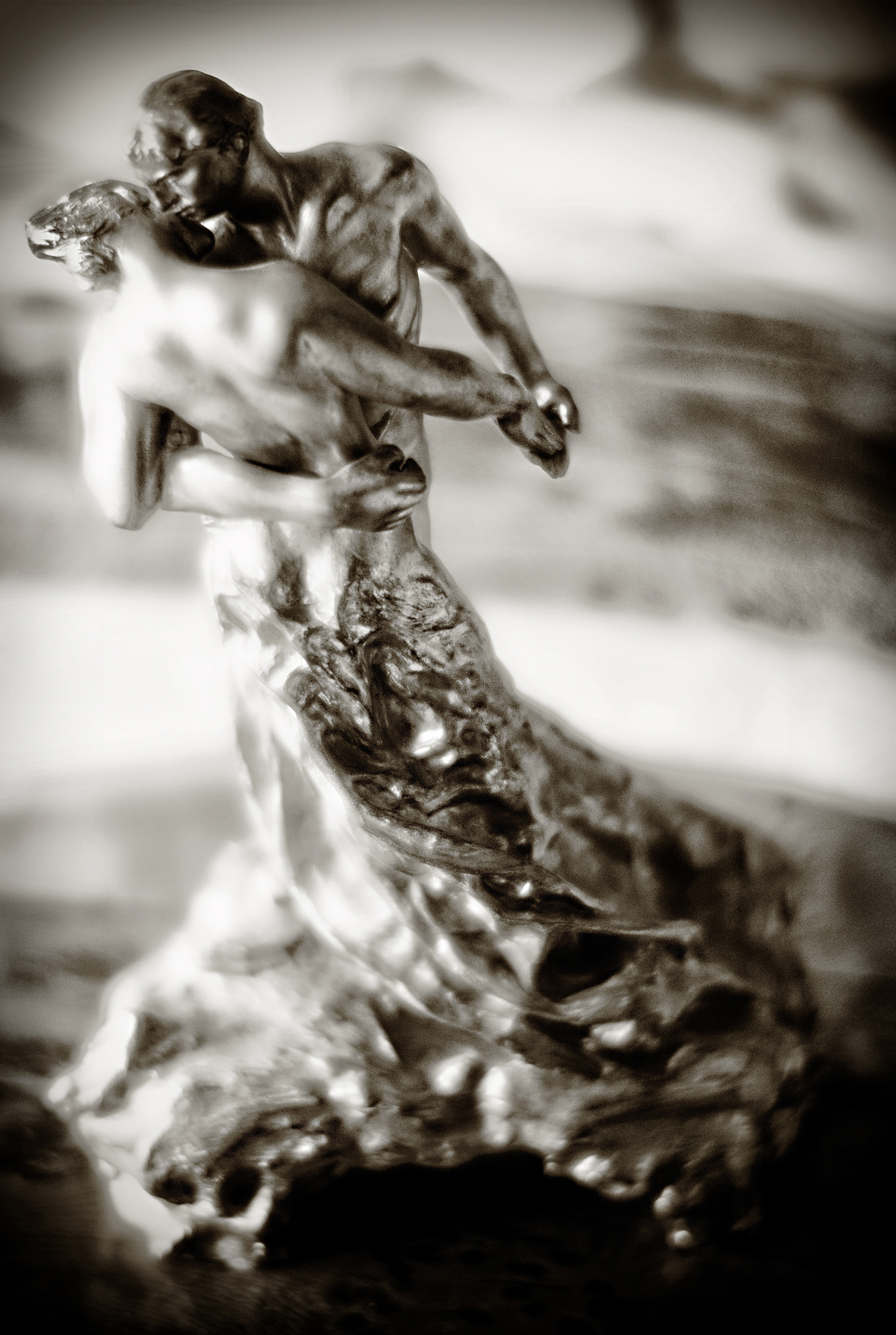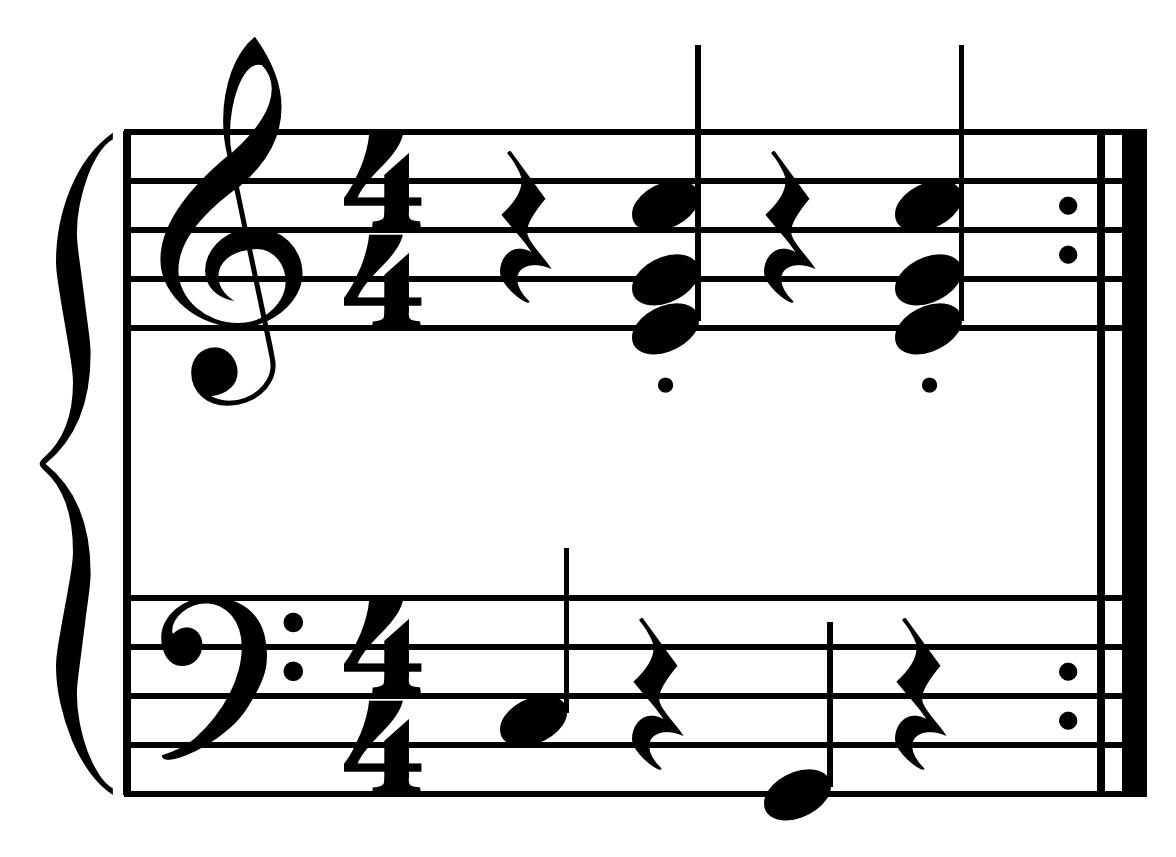|
Duple And Quadruple Metre
Duple metre (or Am. duple meter, also known as duple time) is a musical metre characterized by a ''primary'' division of 2 beats to the bar, usually indicated by 2 and multiples (simple) or 6 and multiples ( compound) in the upper figure of the time signature, with ( cut time), , and (at a fast tempo) being the most common examples. Shown below are a simple and a compound duple drum pattern. : \new Staff : \new Staff Though the upper number ''must be'' divisible by 2, the mere fact that 2 evenly divides the upper figure does not in and of itself indicate a duple metre; it is only a prerequisite. The most common time signature in rock, blues, country, funk, and pop is . Although jazz writing has become more adventurous since Dave Brubeck's ''Time Out'', the majority of jazz and jazz standards are still in "common time" (). Duple time is common in many styles including the polka, well known for its obvious "oom-pah" duple feel. Compare to the waltz. Quadruple metr ... [...More Info...] [...Related Items...] OR: [Wikipedia] [Google] [Baidu] |
Metre (music)
In music, metre (British spelling) or meter (American spelling) refers to regularly recurring patterns and accents such as bars and beats. Unlike rhythm, metric onsets are not necessarily sounded, but are nevertheless implied by the performer (or performers) and expected by the listener. A variety of systems exist throughout the world for organising and playing metrical music, such as the Indian system of '' tala'' and similar systems in Arabic and African music. Western music inherited the concept of metre from poetry, where it denotes the number of lines in a verse, the number of syllables in each line, and the arrangement of those syllables as long or short, accented or unaccented. The first coherent system of rhythmic notation in modern Western music was based on rhythmic modes derived from the basic types of metrical unit in the quantitative metre of classical ancient Greek and Latin poetry. Later music for dances such as the pavane and galliard consisted of ... [...More Info...] [...Related Items...] OR: [Wikipedia] [Google] [Baidu] |
Pop Music
Pop music is a genre of popular music that originated in its modern form during the mid-1950s in the United States and the United Kingdom.S. Frith, W. Straw, and J. Street, eds, ''iarchive:cambridgecompani00frit, The Cambridge Companion to Pop and Rock'' (Cambridge: Cambridge University Press), , pp. 95–105. During the 1950s and 1960s, pop music encompassed rock and roll and the youth-oriented styles it influenced. ''Rock music, Rock'' and ''pop'' music remained roughly synonymous until the late 1960s, after which ''pop'' became associated with music that was more commercial, wikt:ephemeral, ephemeral, and accessible. Identifying factors of pop music usually include repeated choruses and Hook (music), hooks, short to medium-length songs written in a basic format (often the verse–chorus form, verse–chorus structure), and rhythms or tempos that can be easily danced to. Much of pop music also borrows elements from other styles such as rock, hip hop, urban contemporary, ... [...More Info...] [...Related Items...] OR: [Wikipedia] [Google] [Baidu] |
Waltz
The waltz ( , meaning "to roll or revolve") is a ballroom dance, ballroom and folk dance, in triple (3/4 time, time), performed primarily in closed position. Along with the ländler and allemande, the waltz was sometimes referred to by the generic term German Dance in publications during the late 18th and early 19th centuries. History There are many references to a sliding or gliding dance, including ''volte'', that would evolve into the waltz that date from 16th-century Europe, including the representations of the Printmaking, printmaker Sebald Beham, Hans Sebald Beham. The French philosopher Michel de Montaigne wrote of a dance he saw in 1580 in Augsburg, where the dancers held each other so closely that their faces touched. Kunz Haas (of approximately the same period) wrote, "Now they are dancing the godless ''Weller'' or ''Spinner''."Nettl, Paul. "Birth of the Waltz." In ''Dance Index'' vol 5, no. 9. 1946 New York: Dance Index-Ballet Caravan, Inc. pages 208, 211 "The ... [...More Info...] [...Related Items...] OR: [Wikipedia] [Google] [Baidu] |
Oom-pah
Oom-pah, Oompah, Ooumpah or Umpapa is an onomatopoeic term describing the rhythmic sound of a deep brass instrument in combination with the response of other instruments or registers in a band, a form of background ostinato. The oom-pah sound is usually made by the tuba alternating between the root of the chord and the 5th — this sound is said to be the ''oom''. The ''pah'' is played on the off-beats by higher-pitched instruments such as the clarinet, accordion or trombone. Oompah is often associated with '' Volkstümliche Musik'', a form of popular German music, and with polka. In triple time genres such as the waltz it is oom-pah-pah. The musical '' Oliver!'' contains a song named " Oom-Pah-Pah", which is named after the oom-pah. A more modern variation is the playing of contemporary pop and rock songs in an Oompah style, by bands such as Global Kryner (Austria), Oompah Brass (UK) (who dubbed the style "Oompop"), and Brumpah (UK, West Midlands). The American jam ban ... [...More Info...] [...Related Items...] OR: [Wikipedia] [Google] [Baidu] |
Polka
Polka is a dance style and genre of dance music in originating in nineteenth-century Bohemia, now part of the Czech Republic. Though generally associated with Czech and Central European culture, polka is popular throughout Europe and the Americas. History Etymology The term ''polka'' referring to the dance is believed to derive from the Czech words "půlka", meaning "half-step". Czech cultural historian Čeněk Zíbrt attributes the term to the Czech word ''půlka'' (half), referring to both the half-tempo and the half-jump step of the dance.Čeněk Zíbrt, "Jak se kdy v Čechách tancovalo: dějiny tance v Čechách, na Moravě, ve Slezsku a na Slovensku z věků nejstarších až do nové doby se zvláštním zřetelem k dějinám tance vůbec", Prague, 189(Google eBook)/ref> This name has been changed to "Polka" as an expression of honour and sympathy for Poland and the Poles after the November Uprising 1830-1831. "Polka" meaning, in both the Czech and Poli ... [...More Info...] [...Related Items...] OR: [Wikipedia] [Google] [Baidu] |
Common Time
A time signature (also known as meter signature, metre signature, and measure signature) is an indication in music notation that specifies how many note values of a particular type fit into each measure ( bar). The time signature indicates the meter of a musical movement at the bar level. In a music score the time signature appears as two stacked numerals, such as (spoken as ''four–four time''), or a time symbol, such as (spoken as ''common time''). It immediately follows the key signature (or if there is no key signature, the clef symbol). A mid-score time signature, usually immediately following a barline, indicates a change of meter. Most time signatures are either simple (the note values are grouped in pairs, like , , and ), or compound (grouped in threes, like , , and ). Less common signatures indicate complex, mixed, additive, and irrational meters. Time signature notation Most time signatures consist of two numerals, one stacked above the other: * The '' ... [...More Info...] [...Related Items...] OR: [Wikipedia] [Google] [Baidu] |
Time Out (album)
''Time Out'' is a studio album by the American jazz group the Dave Brubeck Quartet, released in 1959 on Columbia Records. Recorded at Columbia's 30th Street Studio in New York City, it is based upon the use of time signatures that were unusual for jazz such as , and . The album is a subtle blend of cool and West Coast jazz. The album peaked at No. 2 on the ''Billboard'' pop albums chart, and was the first jazz album to sell a million copies. The single " Take Five" off the album was also the first jazz single to sell one million copies. By 1963, the record had sold 500,000 units, and in 2011 it was certified double platinum by the RIAA, signifying over two million records sold. The album was inducted in the Grammy Hall of Fame in 2009. The album was selected, in 2005, for preservation in the United States National Recording Registry by the Library of Congress as being "culturally, historically, or aesthetically significant". Background The album was intended as an exp ... [...More Info...] [...Related Items...] OR: [Wikipedia] [Google] [Baidu] |
Dave Brubeck
David Warren Brubeck (; December 6, 1920 – December 5, 2012) was an American jazz pianist and composer. Often regarded as a foremost exponent of cool jazz, Brubeck's work is characterized by unusual time signatures and superimposing contrasting rhythms, Metre (music), meters, tonality, tonalities, and combining different styles and genres, like classic, jazz, and blues. Born in Concord, California, Brubeck was drafted into the US Army, but was spared from combat service when a International Red Cross and Red Crescent Movement, Red Cross show he had played at became a hit. Within the US Army, Brubeck formed one of the first racial integration, racially diverse bands. In 1951, he formed the Dave Brubeck Quartet, which kept its name despite shifting personnel. The most successful—and prolific—lineup of the quartet was the one between 1958 and 1968. This lineup, in addition to Brubeck, featured saxophonist Paul Desmond, bassist Eugene Wright and drummer Joe Morello. A U.S. Dep ... [...More Info...] [...Related Items...] OR: [Wikipedia] [Google] [Baidu] |
Funk
Funk is a music genre that originated in African-American communities in the mid-1960s when musicians created a rhythmic, danceable new form of music through a mixture of various music genres that were popular among African-Americans in the mid-20th century. It deemphasizes melody and chord progressions and focuses on a strong rhythmic groove of a bassline played by an electric bassist and a drum part played by a percussionist, often at slower tempos than other popular music. Funk typically consists of a complex percussive groove with rhythm instruments playing interlocking grooves that create a "hypnotic" and "danceable" feel. It uses the same richly colored extended chords found in bebop jazz, such as minor chords with added sevenths and elevenths, and dominant seventh chords with altered ninths and thirteenths. Funk originated in the mid-1960s, with James Brown's development of a signature groove that emphasized the downbeat—with a heavy emphasis on the first be ... [...More Info...] [...Related Items...] OR: [Wikipedia] [Google] [Baidu] |
Simple Meter
In music, metre (British spelling) or meter (American spelling) refers to regularly recurring patterns and accents such as bars and beats. Unlike rhythm, metric onsets are not necessarily sounded, but are nevertheless implied by the performer (or performers) and expected by the listener. A variety of systems exist throughout the world for organising and playing metrical music, such as the Indian system of '' tala'' and similar systems in Arabic and African music. Western music inherited the concept of metre from poetry, where it denotes the number of lines in a verse, the number of syllables in each line, and the arrangement of those syllables as long or short, accented or unaccented. The first coherent system of rhythmic notation in modern Western music was based on rhythmic modes derived from the basic types of metrical unit in the quantitative metre of classical ancient Greek and Latin poetry. Later music for dances such as the pavane and galliard consisted of music ... [...More Info...] [...Related Items...] OR: [Wikipedia] [Google] [Baidu] |
Country Music
Country (also called country and western) is a popular music, music genre originating in the southern regions of the United States, both the American South and American southwest, the Southwest. First produced in the 1920s, country music is primarily focused on singing Narrative, stories about Working class in the United States, working-class and blue-collar worker, blue-collar American life. Country music is known for its ballads and dance tunes (i.e., "Honky-tonk#Music, honky-tonk music") with simple form, folk lyrics, and harmonies generally accompanied by instruments such as banjos, fiddles, harmonicas, and many types of guitar (including acoustic guitar, acoustic, electric guitar, electric, steel guitar, steel, and resonator guitar, resonator guitars). Though it is primarily rooted in various forms of American folk music, such as old-time music and Appalachian music, many other traditions, including African-American, Music of Mexico, Mexican, Music of Ireland, Irish, and ... [...More Info...] [...Related Items...] OR: [Wikipedia] [Google] [Baidu] |
Blues
Blues is a music genre and musical form that originated among African Americans in the Deep South of the United States around the 1860s. Blues has incorporated spiritual (music), spirituals, work songs, field hollers, Ring shout, shouts, chants, and rhymed simple narrative ballad (music), ballads from the African-American culture. The blues form is ubiquitous in jazz, rhythm and blues, and rock and roll, and is characterized by the Call and response (music), call-and-response pattern, the blues scale, and specific chord progressions, of which the twelve-bar blues is the most common. Blue notes (or "worried notes"), usually thirds, fifths or sevenths flattened in Pitch (music), pitch, are also an essential part of the sound. Blues shuffle note, shuffles or walking bass reinforce the trance-like rhythm and form a repetitive effect known as the groove (popular music), groove. Blues music is characterized by its lyrics, Bassline, bass lines, and Instrumentation (music), instrumen ... [...More Info...] [...Related Items...] OR: [Wikipedia] [Google] [Baidu] |








